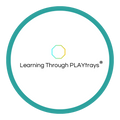Understanding Reggio, Montessori, Waldorf, and HighScope in 5 Minutes + Sensory Play Ideas

What the Top 4 Early Childhood Philosophies Say About Sensory Play
Sensory play isn't just a fun activity—it’s a foundational learning experience across the world’s leading early childhood education philosophies. Reggio Emilia, Montessori, Waldorf, and HighScope may each have unique approaches, but they all recognize the value of sensory-rich environments. Let’s explore how each philosophy embraces sensory play, and why a sensory tray (also known as a Tuff Tray, Tuff Spot, or PLAYtray) is the perfect fit for all four.

Why sensory play is a must in Reggio, Montessori, Waldorf, and HighScope settings
🌱 Reggio Emilia
🧒 Child-led, open-ended exploration
🌿 Uses natural materials + "provocations"
🖼️ Environment = the “third teacher”
🧩 Montessori
🧠 Sensorial learning is foundational
🧺 Uses real objects with isolated qualities (color, texture)
🎯 Builds focus, order, and independence
🍂 Waldorf
🌳 Nature-rich, seasonal materials
🎨 Emphasis on rhythm, beauty, and imagination
🚫 Avoids overstimulation
🔍 HighScope
🛠️ “Plan-Do-Review” learning cycle
✋ Hands-on materials support active learning
🧠 Focus on initiative + problem-solving
🌱 Reggio Emilia & Sensory Play
In the Reggio Emilia approach, sensory play is central to learning. Children are viewed as capable, curious individuals who construct their own understanding through hands-on exploration. The environment is considered the “third teacher,” and materials—especially natural and sensory-rich ones—are deliberately chosen to invite open-ended investigation ( WeSkool Reggio ). Sensory trays in this setting are used as provocations, often filled with nature elements, light, color, or texture to spark a child's creative response and storytelling.



🧩 Montessori & Sensory Play
Montessori classrooms emphasize sensorial materials designed to isolate specific qualities like color, texture, temperature, sound, and weight. Dr. Maria Montessori believed that learning begins through the senses and that purposeful sensory experiences support order, concentration, and independence ( American Montessori Society ). Montessori-aligned sensory play typically uses real-life objects in a calm, intentional setup—making sensory trays ideal for curated, hands-on activities that respect the child’s focus and autonomy.

🍂 Waldorf & Sensory Play
In Waldorf education, sensory play is deeply rooted in nature and rhythm. Rudolf Steiner emphasized the importance of engaging all the senses through seasonal crafts, natural materials, and imaginative play. Waldorf sensory experiences avoid overstimulation and instead nurture a child’s inner development through beautiful, simple materials like wool, water, wood, and sand ( Waldorf Education ). A sensory tray fits beautifully into this philosophy by offering a grounded, tactile experience that changes with the seasons and celebrates beauty.

🔍 HighScope & Sensory Play
HighScope encourages “active participatory learning,” where children learn by doing and reflecting on their experiences. Sensory play supports the development of key learning areas like initiative, problem-solving, and fine motor skills. Teachers in HighScope programs observe closely and scaffold play based on children’s interests, often integrating sensory bins and materials as part of the daily “Plan-Do-Review” cycle ( HighScope.org ). Sensory trays allow for easy setup of hands-on tasks that can be child-initiated and teacher-supported.

Rooted in Play: The History Behind Today’s Top Learning Philosophies
🌱 Reggio Emilia Approach
🌍 Originated in Reggio Emilia, Italy after World War II
👨🏫 Founded by Loris Malaguzzi and local parents in the 1940s
🖼️ Emphasizes the “ 100 Languages of Children ” — the many ways children express themselves
🧩 Montessori Method
👩🏫 Developed by Dr. Maria Montessori , an Italian physician
📆 First Montessori classroom opened in 1907 in Rome, called Casa dei Bambini
🌍 Now practiced in over 140 countries globally
🍂 Waldorf Education
🧑🎓 Founded by Rudolf Steiner , an Austrian philosopher and social reformer
📆 First Waldorf school opened in 1919 in Stuttgart, Germany
🌈 Based on Anthroposophy — the idea that education should develop body, soul, and spirit
🔍 HighScope Approach
🏫 Created in the 1960s in Michigan, USA
🧠 Originated from the Perry Preschool Project — a groundbreaking study on early intervention
👨🏫 Founded by psychologist David Weikart
🧠 The Common Thread: Why Sensory Play Matters Across All Four
Despite their differences, all four philosophies agree: sensory play builds brains. Whether it's a Reggio child mixing flower petals in water, a Montessori student refining their sense of touch, a Waldorf child scooping dyed rice by hand, or a HighScope learner exploring with tools and textures—each experience nurtures cognitive, emotional, and physical development. Sensory play provides the foundation for problem-solving, creativity, and language.
A Note from Kamilla, Founder of Learning Through PLAYtrays
FUN FACT
I’m not just the founder of Learning Through PLAYtrays — I’m a certified (2008) Early Childhood Educator! Back in 2015 , I was certified and endorsed as a HighScope Infant Toddler Teacher through the HighScope Foundation (Michigan). I worked in a HighScope Certified Childcare Center (Ontario) , and let me tell you — the Plan-Do-Review process is still one of the best components I’ve ever seen in early learning. Why? Because it gives children real ownership. They plan their play , do the activity , and then reflect on what they learned. It’s a simple, powerful routine that builds critical thinking, confidence, and language skills. And yes — it works beautifully in a sensory tray setup!
Later, I spent two years in a Reggio Emilia-inspired kindergarten as an international teacher trainer. And something big changed in me during that time…I started collecting leaves, flowers, and rocks everywhere I went! Why? Because Reggio taught me to slow down, observe nature with fresh eyes, and see everyday materials as invitations to play and create. I loved making nature crafts with the kids , and spent so much more time in our outdoor classroom .

Why a Sensory Tray Is the Perfect Tool
Also called a Tuff Tray, Tuff Spot, or PLAYtray, the sensory tray is a flexible, child-centered tool that supports all four approaches. It can hold natural objects for Waldorf, curated materials for Montessori, open-ended provocations for Reggio, and scaffolded explorations for HighScope. Its defined boundary helps contain mess while giving children a dedicated space to explore.

